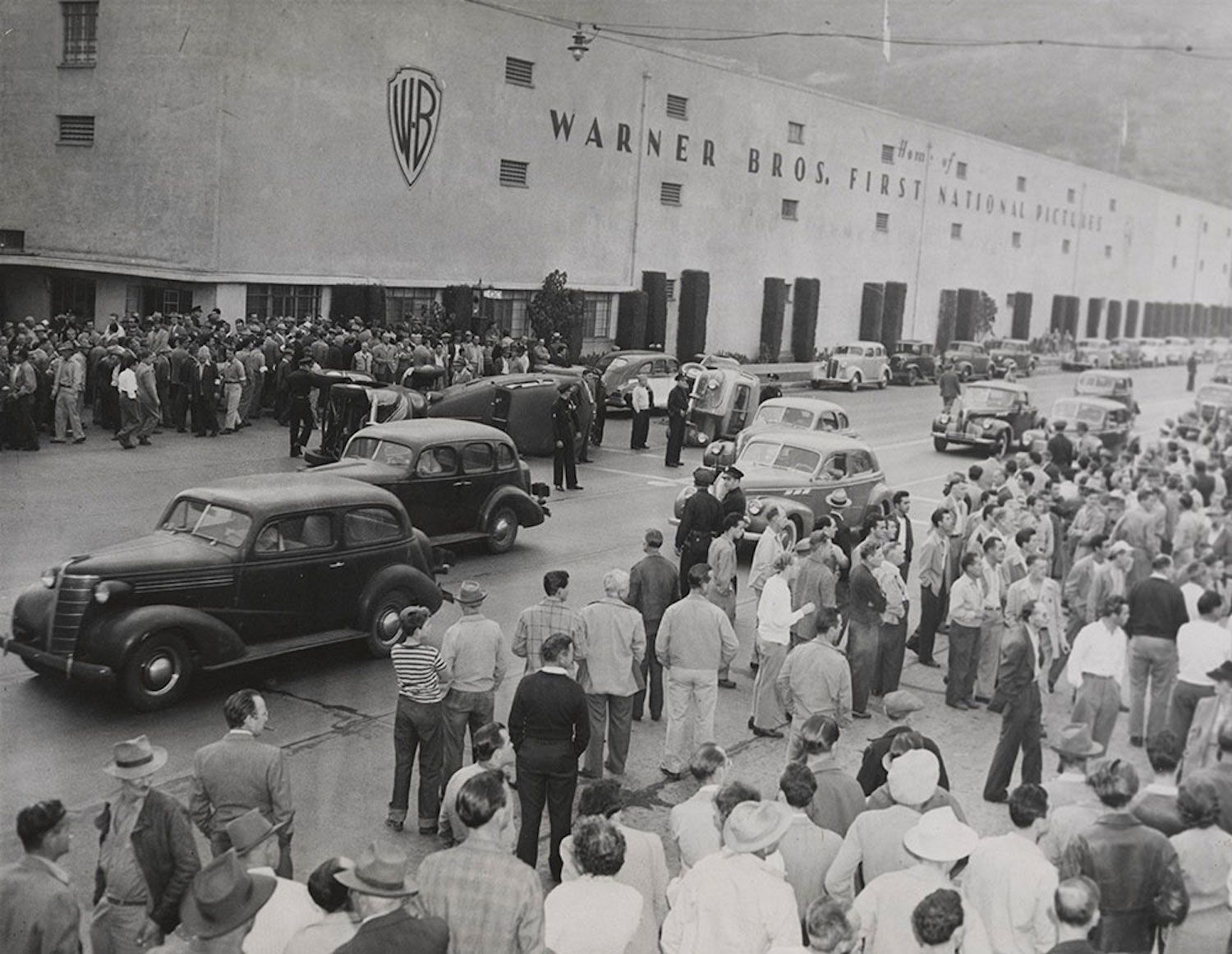
Strike Back - Ending Hollywood's Historic War on Workers
On October 5th, 1945, Hollywood Bloody Friday, 300 set decorators from the Conference of Studio Unions (CSU) converged on the gates of Warner Brothers to picket for their six-month long, 10,000-worker-strong strike. When they tried to stop scabs (non-striking workers) from accessing the lot, they were met with fire hoses, billy clubs, chains, hammers, pipes, tear gas, and night sticks.
On October 5th, 2021, 98% of eligible workers voted "yes" to authorize a strike affecting 60,000+ entertainment industry workers across 350+ local unions.
What will they be met with?
From the mob rule of the 1930s and 40s, to the blacklisting of the 50s, to the modern-day fear campaigns, targeting whistleblowers who expose powerful industry leaders—Hollywood has historically adopted underhanded and violent tactics to suppress abuses and curtail workers' rights.
In 1934, less than one year after President Roosevelt signed the National Recovery Act into law, studios colluded with known Chicago mobster George Brown to install him as president of IATSE, forcing his opponents to drop out of the race using death threats and physical violence. With the help of his toadie, Willie Bioff, Brown used those same tactics to implement weak labor contracts and high union dues, as well as putting IATSE in direct competition with sister unions—one of which was the CSU. Brown and Bioff were eventually charged with racketeering in 1941 for accepting around $1 million in bribes from the studios, but their successors—Richard Walsh and Roy Brewer—proved to be just as corrupt.
During the CSU's strike, Walsh and Brewer negotiated their own deal with studios to lock out CSU members from sets and staff productions with IATSE members. Despite many rank-and-file IATSE members walking off set in solidarity with their union brothers, the CSU was forced into continuing a costly 13-month strike, crippling and ultimately destroying the union. Thousands of men and women lost their jobs, their homes, and their futures. Their picket lines—the only means they had to defend themselves—were broken. Hundreds were rounded up by police, thrown in jail, and tried in court with dozens of compatriots at a time.
When brute force failed to break the other unions, Hollywood utilized a popular villain of the times: Communism. In 1941, Walt Disney himself took out an ad in Variety, declaring that "Communist agitation" was behind a cartoonists and animators' strike. In 1947, the House Un-American Activities Committee (HUAC) declared its intention to investigate if Hollywood was supplying Communist propaganda. Roy Brewer testified that the "disturbances" in Hollywood were caused “by Communists." Then-president of the Screen Actor's Guild, Ronald Reagan (yes, that Ronald Reagan), helped to pressure his own union into crossing the picket line during the 1945 and 1946 CSU strikes, and testified to HUAC against the unions' "communist sympathies." During the blacklisting practices of the late 40's and early 50's, writers, actors, and producers with pro-union and progressive views were named and shamed as members of the Communist Party, whether or not they were actually members. Hollywood also lobbied for federal legislation, like 1947's Taft-Hartley Act, which introduced some of the first "right to work" laws and crippled union recruitment through corporate loopholes—many of which still exist today.
What effect did all of this end up having on Hollywood? A culture of abusive bosses, low pay, and hazardous working conditions that has continued for decades, as well as a fervent anti-worker sentiment among investors and producers. How many stories have we heard from our friends on set about falling asleep at the wheel after a 16-hour day? Or an enraged producer throwing a stapler at a PA's head? Or a utility donating plasma to pay rent after crewing a multimillion-dollar Netflix series? Or a grip nearly falling off a ledge trying to get "the shot?"
How many of these stories were told as rites of passage? Battle scars to be proud of, rather than problems to be solved?
Fortunately, workers continue to 'strike' back—with success! In 2000, SAG-AFTRA's 135,000 members struck against the advertising industry to secure fair payments for commercials. WGA strikes over the decades—culminating in the 2007-08 strike—paved the way for residuals and new media contracts foundational to the industry. Recent negotiations between the WGA and the big agencies have been fraught with conflict over streaming residuals and packaging deals. Yet, one by one, the agencies caved to the WGA's demands.
Now, unprecedented worker unity has compelled 98% of IATSE members to vote for a strike for reasonable rest, guaranteed lunch breaks, and living wages. With this unity comes unprecedented solidarity from the industry at large. Gone are the talks of Communist sympathy and "unnecessary entitlements" (unless you're a Republican member of Congress), replaced with messages of support from A-list talent across the board. With this newfound solidarity comes worker power previously unseen in Tinseltown.
Perhaps now, instead of tear gas and night-sticks, we will meet IATSE picketers with bottles of water and a helping hand.
Update: On October 16, 2021, an agreement was met and the IATSE strike was averted.
*Feature photo by International News Photos. Warner Brothers Strike 1945 - Overturned Cars. [Photographic Prints]. Retrieved from FreeLibrary.org.

